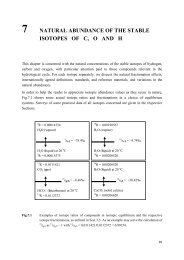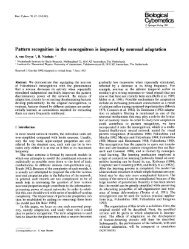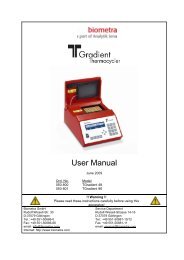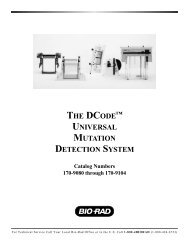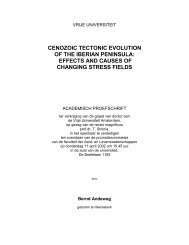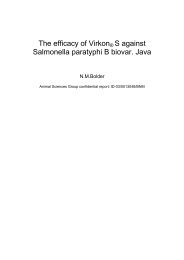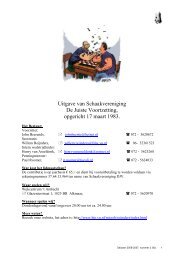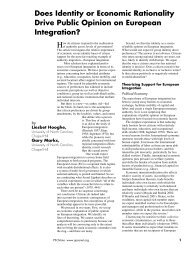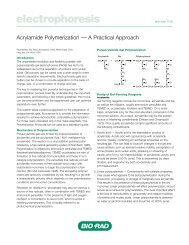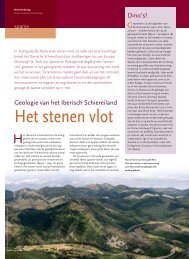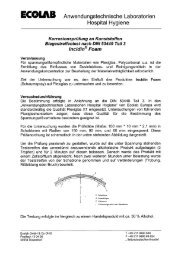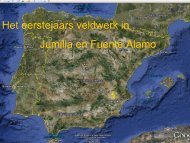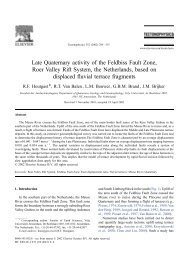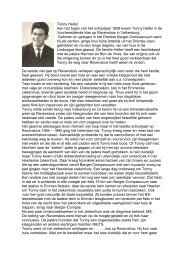DON'T PANIC - falw.vu
DON'T PANIC - falw.vu
DON'T PANIC - falw.vu
Create successful ePaper yourself
Turn your PDF publications into a flip-book with our unique Google optimized e-Paper software.
A GUIDE TO DGGE (V2) Page 10<br />
How much PCR product to load on DGGE?<br />
There is no established amount of PCR product to load on DGGE. However, some things to<br />
consider: the lower the diversity your system, the less DNA you need to load. For example, if<br />
you load 50 uL of DNA from a PCR of a single clone, you will definitely load too much DNA.<br />
However, in a highly diverse microbial community, that PCR product will be split among a large<br />
number of different sequences, making detection of some problematic. Another rule of thumb<br />
suggests that if (ignoring for the moment any issues with PCR bias) a sequence is not at least 1%<br />
of the total population targeted by the primer set, that sequence will be difficult to detect by<br />
DGGE. Thus, specific primers can aid in detecting less abundant populations by narrowing the<br />
range of target population.<br />
From the DGGE group I have seen suggestions that 300-500 ng of DNA is an appropriate<br />
amount to load per lane – for an environmental sample, or more specifically, 2-20 ng per band,<br />
when using non-EtBr stains. Obviously, for PCR product of a pure culture or clone, you’ll need<br />
significantly less. Although not widely done, it probably would be a good idea to quantify PCR<br />
products prior to loading on DGGE gels, so as to be able to compare intensities between lanes. If<br />
you have weak PCR, you can load large volume into each lane by loading twice. That is, fill the<br />
well, electrophorese for a while and the load the rest of the PCR product. Since DNA fragments<br />
often stop when they reach their specific denaturant concentration, and run times are probably<br />
longer than necessary, there does not appear to be any negative effect resulting from sequential<br />
DNA addition.<br />
One thought – the size of the PCR fragment may also be a consideration. Given the same copy<br />
number, a longer DNA fragment will yield a stronger fluorescent signal.<br />
How much DNA to put in each PCR reaction?<br />
This topic has come up recently in the Yahoo group. Ideally, a similar amount of DNA should be<br />
added to each PCR reaction, but in reality, this is often time consuming to do. This requires the<br />
measurement of DNA concentration from each DNA extract, and then dilution of each DNA to<br />
the same final concentration. This may be particularly important for quantitative PCR. For nonquantitative<br />
PCR of environmental samples ultimately used for DGGE, there seems to be a range<br />
of 10 to 100 ng (per 50 microliter reaction) in use. I have seen on the DGGE Yahoo group that<br />
some users have been diluting genomic DNA prior to adding it to PCR. Diluting DNA to avoid<br />
contaminants such as humic acids/polysaccharides may work sometimes, but in general, it is<br />
probably better to clean up the DNA, even if you loose a proportion of your DNA. The article<br />
below suggests that diluting DNA makes reproducibility worse.<br />
• Chandler DP, Fredrickson JK, and Brockman FJ. 1997. Effect of PCR template<br />
concentration on the composition and distribution of total community 16S rDNA clone<br />
libraries. Molecular Ecology 6: 475-482<br />
Some situations can be far more complex. As Kim discusses in post #1267, one can have a<br />
situation where there is a variable amount of non-target genomic DNA. Thus, it may not be<br />
entirely fair to add the same total amount (ng) of genomic DNA to each PCR reaction, if the<br />
Stefan J. Green Stefan@stefangreen.com



